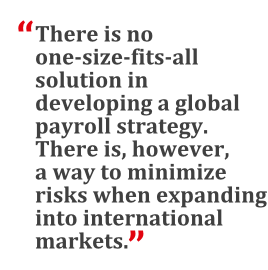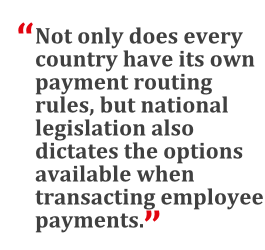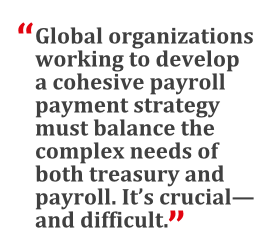 An efficient payroll process is one of the fundamentalmainstays of every successful organization. Salary payments must bedelivered on time if a company wants to establish long-termsustainability. An employee who hasn't received his or her wageswill not only be unhappy, but could potentially foment discontentamong colleagues, leading to a broader decrease in morale andtrust.
An efficient payroll process is one of the fundamentalmainstays of every successful organization. Salary payments must bedelivered on time if a company wants to establish long-termsustainability. An employee who hasn't received his or her wageswill not only be unhappy, but could potentially foment discontentamong colleagues, leading to a broader decrease in morale andtrust.
Organizations often find that the impediments to achievingaccurate, timely payroll payments increase exponentially when theyexpand operations abroad. A company doing business internationallyfaces a host of potential challenges, including many factors thatare outside of its control—from unstable governments and littlebanking infrastructure in regions like Africa, to highlyrestrictive legislative protocols like those across Asia. In globalbusinesses, effective payroll processes require treasury officersto not only manage cash flows, but also prepare for foreigncurrency volatility, help plan corporate structures that optimizetax policy in the different jurisdictions, and ensure compliancewith anti-money laundering laws.
|Treasury needs to be running payroll-related due diligencearound each country the business is entering. A global company thatmakes the mistake of applying the same approach to payroll fundingfor all the countries in which it has employees will most likelyfind itself in violation of local laws. Many countries havespecific rules around how employees and taxes are funded, rulesthat don't apply for other types of payments.
|However, every multinational can—and should—establish a globalstrategy for its payroll payments. Instituting an internationalpayments strategy will save an organization from having to trackelaborate and highly individualized solutions for each of itsregional divisions. Once the overarching strategy is in place, acompany can adjust its process, where necessary, to meet eachcountry's local regulatory requirements without losing its coregoals and principles.
|Centralization, Decentralization, or Something inBetween
Perhaps the most basic decision a company must make around itsglobal payroll delivery is whether it will consolidate payrollactivities into shared services or whether payroll services will bedelivered at the country level. How payroll is delivered should bea major consideration when developing a global payroll fundingstrategy.
| Manyorganizations already use global or regional shared service centersto deliver finance and human resources to business units around theworld. The benefits of centralizing various global financeactivities are well-documented; primary among them are thecentralized function's economies of scale and increased visibilityfor corporate management.
Manyorganizations already use global or regional shared service centersto deliver finance and human resources to business units around theworld. The benefits of centralizing various global financeactivities are well-documented; primary among them are thecentralized function's economies of scale and increased visibilityfor corporate management.
However, coordinating payroll funding within a single globalfunction presents challenges as well. The farther a shared servicecenter is from a payroll payment's target destination, the morelikely that centralized payroll management will lead to delays, dueto issues like lack of knowledge among shared service center staffabout local customs or bank holidays. In addition, most countrieshave their own banking formats and local requirements.
|Understanding and complying with local regulations in a regionalor centralized model can be difficult to manage. A local partnercan help a company manage the idiosyncrasies of the country'spayroll environment. It can also alert the business if local lawschange, so that the company remains compliant.
||In laying the foundation for a company's overall payrollstrategy—and, in particular, in determining whether to centralizepayroll operations—the corporate treasurer needs to consider thesefour important factors that affect the company's ability to deliverinternational payments:
|Where are your funds?
The first question to consider in constructing a global payrollpayment strategy is what proportion of the company's localoperations have the ability to generate enough revenue within thecountry of operation to self-fund the local payroll. If theorganization earns sufficient revenue within a country to pay theemployees it has stationed there, that significantly reduces thecomplexity of delivering salaries via a local payroll function.
| Localpayroll payments funded by the company's in-country liquidityeliminate the need for sophisticated cross-border payments andcurrency exchange, and also minimize the tax issues associated withmoving money across borders. For a business unit that generatesenough funds in-country to cover payroll liabilities, the mostcommon solution is to have a local payroll team make salary and taxpayments from a local bank account.
Localpayroll payments funded by the company's in-country liquidityeliminate the need for sophisticated cross-border payments andcurrency exchange, and also minimize the tax issues associated withmoving money across borders. For a business unit that generatesenough funds in-country to cover payroll liabilities, the mostcommon solution is to have a local payroll team make salary and taxpayments from a local bank account.
In contrast, companies that opt for a global payroll sharedservice center usually have the central group make cross-borderpayroll payments for all the divisions they serve, to maximizeeconomies of scale and control. The shared service group may haveto contend with different systems, banks, interfaces, processes,rules, customs, and levels of service in every locale it serves.Most companies desire a funding solution that matches their payrollprocess delivery model, and organizations typically move toward aregional or global funding solution as they regionalize orglobalize payroll services.
|Businesses that use a local team, making payments out of a localaccount, may or may not use a bank account dedicated exclusively topayroll. A division with enough local income to self-fund itspayroll most likely has an existing banking relationship within thecountry, an account into which it deposits revenues. The groupcould use the same account to fund in-country payrollliabilities.
|Payroll funding from a local bank account is usually thelowest-cost solution. Utilizing a corporate account in this wayenables a multinational to avoid the compliance difficultiesinherent in setting up another international bank account, as wellas the fees associated with opening and operating a new account.However, using the general business account for payroll may openthe organization to problems of wage visibility, particularlywithin small payroll populations. If accounts payable is managed bya division head who would not otherwise have access to informationabout salaries within the division, word may spread regardingdifferences in pay packets, affecting morale and staffsatisfaction.
|Alternatively, a company that establishes a separate payrollaccount in a country where it does business could outsource payrollmanagement in that country, decreasing the likelihood thatemployees will discover what their colleagues are earning.Furthermore, decision-makers could select an outsourcing providerbased on its expertise in local tax structures, reducing thecompliance burden placed on the corporate team.
|
What does each country allow?
As companies continue to expand abroad, they must navigate moreand more regulations with each new country of operation. Not onlydoes every country have its own payment routing rules, in areassuch as supporting documentation and tax IDs, but nationallegislation also dictates the options available when transactingemployee payments.
|Some countries, for example, require a company to have anemployer-named account—a bank account held under the name of thelegal entity within the respective country—from which to pay staff.Other countries do not permit cross-border payroll payment to payliabilities (employee and/or taxes). Understanding the unique legalrequirements in every jurisdiction in which the company doesbusiness is crucial in developing a viable, cost-effectivecorporate payroll strategy.
|
How big is your payroll population in eachlocale?
The size of your employee population should play an importantrole in determining your payroll strategy. An organization with 10employees in a particular country might not want to invest the timeand funds necessary to develop the infrastructure for in-countrypayroll. If the country's regulations permit it, a cross-borderpayments process will often be the most practical strategy in thisscenario. On the other hand, if the organization intends to expandsubstantially within the country, using a cross-border paymentsstrategy will dramatically increase payroll complexity as thebusiness grows.
|Likewise, the more team members an international divisionincludes, the more complicated management of all the paymentrouting details becomes. Establishing local banking relationshipsand developing compliance expertise may be the better option incountries with a large employee base, or projections of rapidgrowth, to ensure more accurate cash flow management and timelysalary payments.
|When will you manage your foreignexchange?
Foreign exchange volatility is an inherent challenge forcompanies embarking on global expansion. If any overseas businessunit doesn't generate sufficient funds to pay its employeeslocally, making payroll will require cross-border funds transfers.Corporate treasury will therefore need to take a proactive stancetoward decreasing the effects of market fluctuations, to ensurethat the company and employees are safeguarded against a drasticmovement in their currency.
|It is important to understand the organization's ongoing budget,expenses, and exposures in each local currency well in advance ofmaking international payments. Understanding these factors willhelp the corporate treasury team build the foundation for a soundhedging strategy that mitigates exposures on a monthly, quarterly,or annual basis. This is crucial for all business operations,obviously, but ensuring that the company has adequate funds foreach payroll cycle in each country where employees are locatedensures that employees will always be paid on time. In contrast,taking a reactive position and leaving complex processes to thelast minute may put the company in a difficult position when paydayarrives. Companies that need help can turn to technology and/or athird-party foreign exchange expert for help determining the bestblend of solutions, including natural hedges of receivables andpayables as well as hedging instruments with purchasing portions atspot.
||Organizations that handle payroll through a globally centralizedshared service center generally make payments from a single globalbank. This model can be more efficient, and certainly increasesvisibility and control for corporate management. But managingcompliance with complex regulations in many different jurisdictionscan be challenging for the central group.
|In addition, the concept of a true global bank has diminishedsince the 2008 financial crisis. Decision-makers need to understanda bank's capabilities to deliver payroll within each countryin which they have operations. Banks that work solely throughmulti-layer correspondence can cause delivery delays and/or canhave issues in resolving payment investigations due to lack oflocal expertise. The ideal institution/payment provider will havemultiple entry points providing local expertise and deliverythrough in-country accounts or network.
| Thechallenges inherent in centralizing global payroll lead somecompanies—particularly those with a sizable workforce in each ofseveral countries—to select a decentralized payroll servicedelivery model with either local payroll staff or a domesticthird-party payroll provider, as well as a local bank that catersto each of their markets. Companies that choose a decentralizedmodel do pay a price in terms of visibility and control. Efficiencycan also be a challenge, as maintaining and reconciling multiplerelationships in multiple countries can become a nightmare.
Thechallenges inherent in centralizing global payroll lead somecompanies—particularly those with a sizable workforce in each ofseveral countries—to select a decentralized payroll servicedelivery model with either local payroll staff or a domesticthird-party payroll provider, as well as a local bank that catersto each of their markets. Companies that choose a decentralizedmodel do pay a price in terms of visibility and control. Efficiencycan also be a challenge, as maintaining and reconciling multiplerelationships in multiple countries can become a nightmare.
In some cases, companies have the option of a middle ground.Organizations that aren't happy with either end of thecentralization spectrum should consider managing payroll operationsin regional hubs, using global or regional service providers and/orbanking partners while maintaining a number of in-country payrollcontacts to mitigate time delays.
|Many companies work with a payroll provider to make localpayments on their behalf. Not all payroll providers offer thisservice, and the approach is not without risk. Payroll providersthat are managing funds on behalf of clients need to be fullyvetted before the client allows them to manage its funds. Inaddition, not all countries allow third-party payments for payrollliabilities.
|The key in choosing a path for your organization is to ensurethat you've done your due diligence, and that whatever providersyou use to deliver your payroll have a proven track record withinthe countries or regions in which you've engaged them.
Developing a Payroll Funding Strategy
Ultimately, there is no one-size-fits-all solution in developinga global payroll strategy. A company's decisions must stem from itsinternal infrastructure, taking into account its growth plans,locations of operation, and the specific risks in each countrywhere it does business.
|There is, however, a way to minimize risks when expanding intointernational markets: Create an overall global policy that takesinto consideration the company's goals, its rate of expansion, thenuances of international payments, and where its sources of revenueare located. The corporate payroll payment strategy should describethe degree to which the company expects payroll functions to becentralized; establish the company's global standard for payrollmanagement resources (e.g., outsourced services, internal sharedservices, local payroll staff in different countries); establishwhether payroll will involve cross-border payments; and describewhether the company expects to use local banks in each area, or touse a single global bank for payroll wherever the local regulatoryenvironment allows it.
||Companies should analyze their current situation to determinewhich model will work best for each country in which they haveemployees. The decision tree framework should look something likethis:
- What is the strategic vision for this country—e.g., largeexpansion or just dabbling to test the market?
- Employee population—large or small?
- Does the country self-generate enough funds to supportpayroll liability?
- Does the business require a local bank account aside frompayroll?
- Risk analysis: What are the controls necessary to securefunding?
- Local regulatory requirements: Do they allow cross-borderpayment or third-party trust?
- What are the local options: Is there a payroll providerthat can make third-party payments?
- What is the company's global treasury strategy for allpayments? Is there an existing treasury strategy for other types ofpayments, such as accounts payable?
- Does the global treasury strategy support the needs ofpayroll?
- Should we handle payroll in-house or outsource?
- Do we want to hold local currency for this country, or isit too volatile?
A fully developed global funding strategy should includepolicies on how to manage the currency fluctuation risk. Financeand treasury must work with payroll to create the optimal solutionfor payroll funding and re-evaluate periodically as conditionschange.
|Global organizations working to develop a cohesive payrollpayment strategy must balance the complex needs of both treasuryand payroll. Including both functions in the creation of the policywill give the company a clearer understanding of the optimalpayroll structure for the organization. It's also crucial—anddifficult—because a solution for payroll may create issues fortreasury, and vice versa. Often, treasury solutions are designedwithout understanding the needs of the payroll organization, suchas off-cycle payments or additional local legislation that appliesto only employee payments. Sometimes when treasury is not meetingthe needs of payroll, payroll staff have to find their ownsolutions.
|Payroll should engage treasury early in the payroll deliverydesign process so the two teams can work through all of the paymentchallenges together. Knowing up front that payroll will need analternative solution gives them the chance to negotiate or findanother solution. An example of this is when treasury requires twosign-offs to make payments and there is a 24-hour turnaround time,but payroll needs to make a manual payment the same day to complywith local legislation.
|It is important to make a payroll policy flexible in case thepayroll and/or treasury function needs to deviate from the idealstate for unforeseen circumstances. As an example, the policy mightprovide guiding principles for a centralized model, but entry intoRussia might require funds to be held within an employer-namedaccount, requiring a more decentralized model for that country. Ifthe policy is too strict, solving it proactively will be difficult.Establishing a policy with limited complexity but sound guidingprinciples, to reduce risks while being compliant, will set asecure foundation to closely follow whilst allowing the team to actwhen the ideal state cannot be achieved due to local regulatoryrequirements. Once payroll and treasury reach a high-levelunderstanding, they will be in a position to adjust that strategyto fit fluctuating global markets, adapting to a multicultural andfrequently unpredictable world.
|——————————————
| Don Banowetz, CTP, is a regional director forCambridge Global Payments. Banowetz has over 10years of experience working in retail banking, commercial lending,and financial technology with a concentration oninternational treasury and foreign currency. In his current role asa regional director with Cambridge Global Payments, he oversees theSouthern U.S. Region, and works nationally within key niches suchas higher education, global payroll, and global mobility.
Don Banowetz, CTP, is a regional director forCambridge Global Payments. Banowetz has over 10years of experience working in retail banking, commercial lending,and financial technology with a concentration oninternational treasury and foreign currency. In his current role asa regional director with Cambridge Global Payments, he oversees theSouthern U.S. Region, and works nationally within key niches suchas higher education, global payroll, and global mobility.
 Tracy Micciche, MBA, is a senior manager inthe HR transformation group at Deloitte Consulting LLP. Miccichehas worked in human resources for the past 20 years, both as apractitioner and a consultant with a concentration in globalpayroll and HR systems. Her primary focus within the lastdecade has been helping clients solve their global treasury needsfor payroll. She currently works for Deloitte as a senior manager,as a consultant in HR transformation.
Tracy Micciche, MBA, is a senior manager inthe HR transformation group at Deloitte Consulting LLP. Miccichehas worked in human resources for the past 20 years, both as apractitioner and a consultant with a concentration in globalpayroll and HR systems. Her primary focus within the lastdecade has been helping clients solve their global treasury needsfor payroll. She currently works for Deloitte as a senior manager,as a consultant in HR transformation.
Complete your profile to continue reading and get FREE access to Treasury & Risk, part of your ALM digital membership.
Your access to unlimited Treasury & Risk content isn’t changing.
Once you are an ALM digital member, you’ll receive:
- Critical Treasury & Risk information including in-depth analysis of treasury and finance best practices, case studies with corporate innovators, informative newsletters, educational webcasts and videos, and resources from industry leaders.
- Exclusive discounts on ALM and Treasury & Risk events.
- Access to other award-winning ALM websites including PropertyCasualty360.com and Law.com.
*May exclude premium content
Already have an account? Sign In
© 2024 ALM Global, LLC, All Rights Reserved. Request academic re-use from www.copyright.com. All other uses, submit a request to [email protected]. For more information visit Asset & Logo Licensing.











